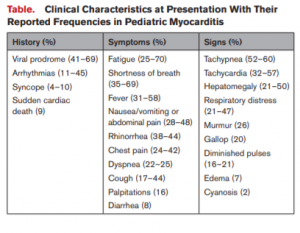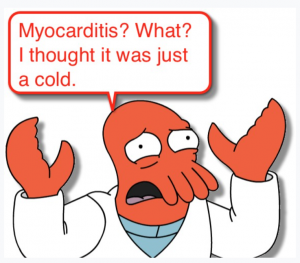In this post I link to and excerpt from Dr. Sean Fox‘s post, Myocarditis, from Pediatric EM Morsels. FEBRUARY 28, 2014.
For an up-to-the-minute resource on pediatric myocarditis, please see Diagnosis and Management of Myocarditis in Children: A Scientific Statement From the American Heart Association [Full-Text PDF]. Originally published, 7 Jul 2021.
Here is the table of pediatric myocarditis history, symptoms, and signs from the above AHA article:
All that follows is from Dr. Fox’s post cited above.
As you know, a common theme of the Ped EM Morsels is Vigilance: many potentially severe conditions present similarly to benign illnesses. KawasakiDisease, Rhabdomyolysis, Crohn’s Disease, and Compartment Syndrome are conditions that come to mind; however, one that warrants special consideration is Myocarditis.
Myocarditis Basics
- Inflammatory process of the myocardium.
- Often caused by a viral infection, but many times no pathogen is identified.
- Rare, but is associated with significant morbidity and mortality!
- Most common cause of heart failure in previously healthy kids!
- Can progress to dilated cardiomyopathy.
- True incidence is unknown, but known cases still comprise a small group.
- Diagnosis often initially missed as it presents with non-specific symptoms.
- The rarity, non-specific presentation, and potential significant M&M necessitates our vigilance!
Myocarditis Presentation
- Often presents with prodromal symptoms.
- Mean duration, in one study, prior to diagnosis was ~7 days.
- Studies have consistently shown that younger children do not typically present with “cardiac” symptoms.
- Adolescents may present with more chest pain complaints similar to adults.
- Most common initial complaints:
- Shortness of breath
- Vomiting and Abdominal Pain
- Poor feeding
- Hypoperfusion (following Syncopal Episodes or Seizures)
- Common MISDIAGNOSES:
- Pneumonia
- Asthma
- URI
- Gastroenteritis
Exam Findings to Look For
- Hepatomegaly
- Respiratory distress (ex, tachypnea)
- Poor Perfusion (ex, mottled skin, decreased cap refill)
- Lethargy
- Tachycardia
Myocarditis and Tachycardia
So I was taught that the child who is persistently tachycardic, after appropriate therapies, needs to have myocarditis considered on the DDx. I do think that this is useful to still consider, but the question is, how useful is the lack of tachycardia in ruling out Myocarditis?
- Sadly, in the three large retrospective studies mentioned in the references, tachycardia was only present in 46 – 58% of cases of myocarditis.
- Lack of tachycardia does not rule out the condition.
Moral of the Morsel
Myocarditis is a difficult diagnosis to make, but an important one to consider! Its rarity will make it much more likely that the patient you are sending home with the “viral illness” or “wheezing” will actually have a mild condition; however, our job is to consider the life-threatening as well as the common.
Get into the habit of always checking for hepatomegaly and skin perfusion in any kid with a respiratory complaint or vomiting. While you are most likely to not find any abnormalities, you will not ever find the important ones if you don’t look for them.
If you are concerned for Myocarditis, check an ECG and a CXR… you could also do a quick bedside ultrasound.






